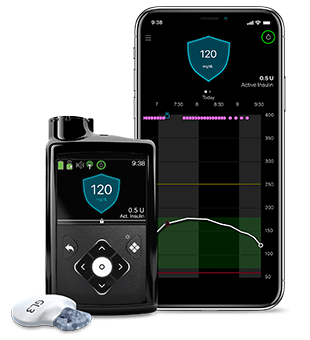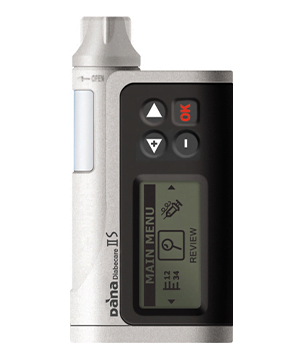When you compare Medtronic MiniMed 770G and Dana DiabeCare IIS insulin pumps, you’re comparing a hybrid closed-loop insulin pump with an open-loop system. For parents and caregivers of a child with type 1 diabetes, the right insulin pump type for that child’s needs and capabilities is vital.
A closed-loop insulin pump reacts to information communicated from a continuous glucose monitoring (CGM) system. Automated basal insulin delivery means you or your child won’t need to make as many adjustments. Add the word ‘hybrid’, and you can control the device manually, too.
That’s what you get with the Medtronic MiniMed 770G. When in AUTO mode, the pump automatically adjusts basal insulin every 5 minutes. Bolus doses of insulin are not automated. You or your child still need to calculate carbs and manually input the correct dose.
An open-loop insulin pump doesn’t automatically adjust basal insulin. You can still use a CGM but need to input CGM results into the pump manually. This is the type of insulin delivery the Dana DiabeCare IIS provides.
While it doesn’t exist yet, Gluroo may support a direct integration with these pumps in the future. In the meantime, Gluroo supports pumps like the Omnipod 5, Omnipod DASH, and DIY Loop. Users who take Multiple Daily Injections (MDI) are also supported with a ton of helpful functionality like easy logging of meals and insulin doses, basal reminders, statistics, and more!
You can download Gluroo for free today on both Android and iOS.
Now, on to the comparison!
Who Are These Insulin Pumps For?
Not only does an insulin pump give a child with T1D a greater sense of freedom, but there’s also no need for multiple injections every day. Although the risk of ketoacidosis (DKA) appears to be slightly higher when children rely on automated insulin delivery (AID), other complications linked to long-term, higher HbA1c results are reduced.
That said, insulin pumps may not be the right choice for every child. It tends to be a choice worth looking into for children who deal with:
- Intensive Insulin Regimen: Insulin pumps are particularly beneficial for children who require intensive insulin therapy, including multiple daily injections with different types of insulin. The pump provides a continuous supply of rapid-acting insulin, mimicking the natural insulin release of the pancreas, which can help improve blood sugar control.
- Insulin Sensitivity: Some children with type 1 diabetes may have high insulin sensitivity, requiring very small doses of insulin. An insulin pump allows for precise micro-dosing and small basal rate adjustments, which can be challenging with traditional injections.
- Needle Anxiety: Insulin pumps eliminate the need for frequent injections, which can be particularly beneficial for children who experience needle anxiety or find injections distressing.
A good endocrinologist or diabetes specialist will help you figure out if an insulin pump is the right choice and teach you or your child (or both) how to safely use an insulin pump.
Medtronic 770G Vs Dana DiabeCare IIS
Looking at these insulin pump types in more detail might help you make an important final decision because automated doesn’t ‘automatically’ mean better. An older child with type 1 diabetes can benefit from learning to manage blood glucose in a more hands-on way with an open-loop system, for example. Or perhaps your insurer expects you to pay a higher percentage of the total costs, so you buy the cheapest insulin pump available.
The primary difference between the Medtronic MiniMed 770G and Dana DiabeCare IIS is in how basal insulin delivery is controlled. Both small machines are tubed, meaning the insulin reservoir connects to the skin via a compatible infusion set.
Features
Medtronic 770G

The MiniMed 770G system automatically adjusts basal insulin, not bolus insulin. The automated basal insulin delivery feature works with a Medtronic Guardian 3 sensor. To receive and transmit that data, you also need a rechargeable transmitter and sensors – all hybrid closed-loop AIDs mean the additional cost of CGM.
Data transmitted from the sensor reports interstitial fluid glucose levels every 5 minutes to the pump. This data allows the pump to adjust basal insulin (if necessary) every 5 minutes, too. The pump, transmitter, and sensor have Bluetooth connectivity and free Medtronic insulin pump software updates mean there’s no need to replace the device for every major tweak.
The accuracy of your Medtronic MiniMed 770G depends on manual calibration and SmartGuard™ technology.
Alerts appear when it’s time to calibrate. This means a finger stick test within the first 2 hours of starting a new sensor, 6 hours after starting a new sensor, and every 12 hours until the sensor stops working. The Medtronic 770G might request additional calibrations if its SmartGuard™ technology thinks CGM results are unusual.
SmartGuard™ enables automatic insulin adjustment (Suspend on Low) and predictive hypo/hyperglycemia prevention (Alert Before Low/Alert Before High). “Suspend on Low” stops basal insulin delivery when the sensor detects a preset low glucose level. “Alert Before Low” and “Alert Before High” notifications predict too low or too high glucose levels for the following 30 minutes.
The Medtronic 770G can also switch between automated and manual modes for basal insulin delivery (the Dana DiabeCare IIS can’t). So, you don’t always have to rely on (or pay for) sensors.
As a Medtronic insulin pump customer, you get free access to Personalized Insights and can check monthly trends, like Time in Range. This service awards badges for glucose-balancing achievements (a great incentive for kids).
Can your child go swimming with a Medtronic 770G insulin pump? Sure. The pump itself can be submerged for 24 hours at a depth of 12 feet. But wear a sensor and swimming time is dramatically reduced to 30 minutes and 8 feet depth.
The Medtronic MiniMed 770G allows bolus speeds of up to 15 units per minute along with timed increments of just 0.025 units. Basal insulin can be adjusted from 0 to 35 units per hour.
The Medtronic insulin pump is approved for use in children from 2 years old and up.
Dana DiabeCare IIS

This relatively cheap insulin pump made by Sooil is approved for children from 7 years and up. That lower price doesn’t mean compromise. There might not be an interaction between the pump and a CGM, but the Dana DiabeCare IIS is known for its ease of use and safety features. The design makes manual data input a walk in the park.
You can use a CGM or finger stick tests, but results will need to be inputted to the pump manually. The advantage of capillary blood testing is that there’s no time lag. And without that sensor, your child can spend 24 hours in the pool!
Bolus increments start at 0.05 units but only go up to 16 units – less than half the volume of the Medtronic. But bolus delivery can be programmed to last a few seconds or over a period of 8 hours. Basal increments can be tiny – as little as 0.01 units. A temporary basal setting administers 0% to 200% of the default dose over 1 to 24 hours and 4 different profiles for different activity levels/dietary changes.
Safety features are very good. Like most models, the Dana DiabeCare has a button lock. Unlike most, it has a PIN-access-only feature. While it’s simple to directly press buttons on the pump, integration with the AnyDANA app (iOS and Android) makes wireless remote control possible via Bluetooth.
Included with your Dana DiabeCare iIS insulin pump are:
- 6 reservoir syringes
- 6 infusion sets
- 1 Easy Setter (reads the correct reservoir volume)
- 2 linking screws (attaches the reservoir to the pump)
- 2 batteries and battery keys
- 1 insulin pump belt
- 1 insulin pump bra pouch
- 1 insulin pump shower pouch
- 1 leather case
- 1 hard case
Performance
Most PWD know of Medtronic or know someone who uses a Medtronic insulin pump.
The opposite is true for Sooil. The Dana DiabeCare IIS might be FDA-approved, but it’s not a popular model in the U.S. With the company working on creating a competitively-priced pediatric hybrid closed-loop insulin pump, we can expect to hear more from Sooil in the future.
Medtronic 770G
The Medtronic 770G performs as it should, partially thanks to the multiple calibrations made during each sensor’s lifespan. The option to switch between Auto and Manual modes is not only handy, but for many it’s an opportunity to kill the regular night-time alarms that remind the user to calibrate or indicate that glucose readings are out of whack. However, turning off Auto Mode, as many users do, is risky.
Overall, this expensive insulin pump doesn’t perform as well as its price suggests it should. But as one of the few approved insulin pumps for very young children, it’s one of the few choices available.
Dana DiabeCare IIS
As the Dana DiabeCare IIS doesn’t integrate with a CGM system, there’s less that can go wrong on a technical or connectivity level. It’s also highly programmable with very few comments about constant alarms and alerts. Price to quality ratio is good, even without CGM integration.
The main problem with the Dana DiabeCare IIS currently is access to materials. To meet the terms of warranty, you must power the pump with a Sooil battery, for example, which is not as easily accessible in the U.S.
Price & Monthly Cost
The prices quoted here are averages. Check with your insurance company to see how much insulin therapy coverage it provides.
Medtronic 770G
A new Medtronic 770G insulin pump costs $5650 (4-year warranty).
Each user-filled reservoir holds up to 3.0 ml/300 units of insulin and costs $35 for 10. Reservoirs are changed together with the infusion set (every 3 days). A pack of 10 infusion sets costs an average of $200.
Medtronic Guardian 3 sensors cost $50 each and last for 7 days, meaning 52 sensors a year.
The CGM transmitter price is approximately $950 and, in principle, should last for a year.
This means a total annual Medtronic 770G cost of approximately $7,800 ($650 a month).
Dana DiabeCare IIS
The Dana DiabeCare IIS insulin pump costs $3000 (4-year warranty)
A pack of 10 syringe reservoirs holds up to 3.0ml/300 units of insulin and costs $10. Reservoirs are changed together with the infusion set (every 3 days). 10 infusion sets cost, on average, $14.
As there is no CGM integration, this cost is optional.
This means a total annual DiabeCare IIS cost of approximately $1040 ($87 a month).
Usability, Comfort, Popularity, and User Experience
Medtronic 770G
Although regular alerts and alarms cause a lot of frustration, many users say they feel safe when using the pump and appreciate the option to use auto mode or manual, or a combination of both. The small size is a big plus point, as is the accompanying app. Even with the newer 780G model available, a percentage of 770G users are happy to continue until the end of warranty (the primary difference between the 2 models is the frequency of calibration).
However, most users say they will be looking for a non-Medtronic model due to the frequency of ‘unnecessary’ alarms and unreliable sensor data during extreme low and high glucose results.
Medtronic customer care is, overall, very helpful. Faulty sensors and transmitters are replaced without charge, but most agree Medtronic customer care is not as good as it used to be.
Dana DiabeCare IIS
Dana DiabeCare fans find this insulin pump very easy to use, but that lack of integration compared to recent insulin pump models can be off-putting.
Some English-language reviews say they actually prefer an open-loop system as they feel more in control. Another voiced advantage is the small, discreet size of the Dana DiabeCare IIS – users say they hardly know it’s there. This might be important for some school-aged children who don’t like the ‘stigma’ of a more visible pump. For kids, the range of available colors is a less vital plus.
One common complaint, however, is that the PIN for guided management is only supplied to the treating doctor. This doctor must be confident you can co-manage the pump before sharing the PIN.
A happy user writes, “No handset to recharge, no pens to fiddle about with – just get my phone out, bolus and I’m done”. And this describes the Dana DiabeCare IIS very well. A simple and reliable (and budget) insulin pump without too many confusing or frustrating added extras.
Final Comparison
| Medtronic 770G | Dana DiabeCare IIS | |
|---|---|---|
| Pump dimensions (inches) | 2.1 width x 3.78 length x 0.96 depth | 1.8 width x 3.6 length x 0.8 depth |
| Weight (ounces) | 3 | 2.2 (1.8 without battery) |
| Waterproof | Pump/reservoir/tubing: 12 ft depth – 24 hours Sensor/transmitter: 8 ft depth – 30 minutes | Pump/reservoir/tubing: 12 ft depth – 24 hours |
| Minimum age | 2 | 7 |
| Power supply | 1 x AA battery | 1 x 3.6 V DC Lithium ½AA |
| Pump storage range | -4°F (-20°C) – 122°F (50°C) 700 hPa – 1060 hPa (10.2 psi – 15.4 psi) | 32.9°F (0.5°C) – 104°F (40°C) 666 hPa – 1413 hPa (9.66 psi – 20.49 psi) |
| Insulin type | Humalog® and NovoLog® | U-100 insulin types |
| Bolus speed | Standard: 1.5 units/minute Quick: 15 units/minute | 12, 30 or 60 seconds per unit |
| Bolus increments (units) | 0.025, 0.05, 0.1 | 0.05, 0.1, 0.5, 1.0 |
| Basal rate delivery (units/hour) | 0 – 35 | 0 – 16 |
| Pump memory | 90 days | Last 300 boluses Last 60 daily insulin totals Last 60 primes Last 50 alarms |
| Compatibility | Medtronic reservoir MMT-332A, 300-unit Medtronic infusion sets Guardian™ Link Transmitter (for CGM) Guardian™ Sensor 3 or 4 Accu-Chek® Guide Link | Sooil reservoir syringe |
| Pairs with: | Specified Android and iOS devices CareLink software MiniMed™ Mobile app | Specified Android and iOS devices AnyDANA app |
| Data sharing? | Up to 5 people | No |
| Warranty | Pump: 4 years CGM transmitter: 1 year | 4 years |
| Average monthly cost (pump, reservoir, infusion sets) | $650 | $87 |
Is Any of These Pumps Right For You?
Neither the Medtronic 770G nor the Dana DiabeCare IIS get rave reviews from U.S. users but for very different reasons. One has become a victim of its huge success, and the other is only just starting to enter the U.S. marketplace.
Insulin pump technology is racing forward, but not in the case of either device in this comparison. The Medtronic 770G was significantly more appreciated in its first years when its technology and integrations were fresh.
Today, it’s judged as an outdated hybrid closed-loop system with an outdated range of functions that don’t match its price tag. But while it may be an expensive insulin pump, Medtronic does enjoy a higher level of health insurance coverage than many other AID manufacturers, like Sooil.
With the Dana DiabeCare IIS, we’ve gone back to basics. This was never meant to be a high-spec innovative insulin pump. It was designed to be simple with a price tag to match. But the reviews that have started to trickle into the West are, overall, appreciative.
This is a good example of why the best insulin pump isn’t always a closed-loop system. At least, not yet.
If you’re curious about other insulin pumps, you can see our post on the Omnipod 5 and the Tandem T:slim x2.




